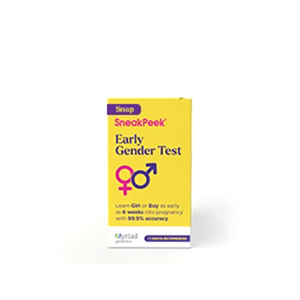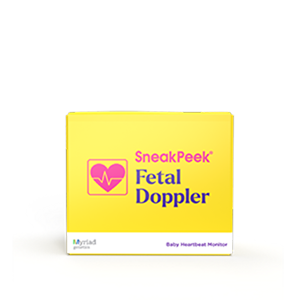Published on October 26th, 2021 and Updated on January 15th, 2024
Check out SneakPeek Gender Test to find out your baby’s gender as early as 6 weeks at over 99% accuracy1!
Is there anything better than precious, peaceful sleep? As any new parent can attest, a good night’s sleep can mean the difference between frustrated tears and joyful laughter, a cluttered inbox and a crossed-off to-do list, dirty sweatpants and clean . . . sweatpants.
We all need sleep to thrive, and it’s no different for our little ones. During the first year of life, your baby’s most important job (aside from flashing that adorable gummy smile at you) is getting the sleep needed for optimal body and brain development. That’s why, as you wait for your little one’s arrival, you might be wondering about baby sleep protocols, including is it safe for babies to sleep on their backs?
The answer is yes—baby sleeping on back is not only safe but it’s also recommended by the American Academy of Pediatrics (AAP) throughout the first year of life. Let’s take a closer look at the reasons why below.
Babies and Sleep
Our little ones need sleep, and lots of it. Those drowsy hours are when their minds develop and bodies grow—and when you can steal some shut-eye of your own.
You’ll know your bundle of joy is ready for a bedtime story when these classic signs of sleepiness are displayed, including:
- Rubbing eyes
- Yawning
- Looking away
- Fussing
If your baby is a newborn, she might signal her readiness to snooze frequently. After all, newborn infants sleep for most of the day (though sometimes in fits and starts, and mostly in stretches of a few hours or less).
As your baby gets bigger (and outgrows that darling dino onesie), her sleep needs will shift. Here’s a breakdown of sleep requirements by age:
- Newborn – Newborns need 16 hours of sleep total, including 8 hours at night and 8 hours during the day.
- 3 months – At three months old, infants need 15 hours of sleep, including 9 to 10 hours at night and 4 to 5 hours during the day.
- 6 months – At six months old, babies need 14 hours of sleep, including 10 hours a night and 4 hours during the day.
- 9 months to 1 year – Babies 9 months to 1-year-old need 14 hours of sleep, including 11 hours of sleep at night and 3 hours during the day.
Belly Up and Back to Sleep: SIDS and Sleeping Positions
No matter what stage of development, your little baby requires a decent dose of sleep. How can you set him up for the safest sleep possible? Here’s a hint: when it comes to safe snoozing, remember “back to sleep.”
The AAP suggests that you should always put your baby to sleep on his back—and that goes for all kinds of snoozes, including naps—until he turns 1-year-old.
This simple guideline comes from research that shows that getting your baby to sleep on his back is “the single most effective action” that you can take to prevent sudden infant death syndrome (SIDS)—the unexplained death of a baby under a year old. In fact, in parts of the world where back sleeping has been promoted as a safety measure, there have been dramatic drops in instances of SIDS. And in areas where stomach sleeping has always been rare, SIDS rates have always been low.
What does sleep position have to do with SIDS?
For every new parent or parent-to-be, the mention of SIDS brings anxiety—and that’s normal. It’s worth noting, however, that SIDS is incredibly rare. It carries an incidence rate of just .035%, according to the CDC.
Still, setting your baby to sleep on his back is a simple, easy-to-follow action that can help you protect your drowsy little dude and put your worries at ease.
To gain a clearer understanding of why back sleeping is so important, let’s take a glance at other sleeping positions and their associated risks.
According to the AAP, stomach sleeping increases the possibility of SIDS by 1.7 to 12.9 times compared to back sleeping. Studies suggest that the comparatively higher instances of SIDS with stomach sleepers, as well as side sleepers, might have something to do with increased chances of the following phenomena:
- Upper airway obstruction – You might be wondering when can babies sleep on their stomachs or is it safe for baby to be sleeping on their side? One of the reasons to stay away from these sleep positions is because when your baby is set on his stomach or side, he might experience blockage of his windpipe. Studies have also shown that babies who sleep on their stomachs have an increased likelihood of developing ear infections, fevers, and stuffy noses.
- Carbon dioxide buildup – This can occur when a baby breathes in his own exhaled breath, something more likely to occur in stomach or side sleeping positions or if he sleeps on a soft mattress with a soft blanket.
- Overheating – Baby has a tough time releasing excess heat when he’s set to sleep on his stomach or side and forced to breathe his own exhaled breath.
Stomach-sleeping babies also experience their slumber differently than babes who snooze on their backs, which poses another danger. Compared to back sleepers, stomach sleepers sleep for longer periods, experience more sudden drops in blood pressure, and have higher arousal thresholds.
But if belly-sleeping babies sleep more deeply and for longer periods of time, isn’t that a good thing?
To put it simply, no. While we as adults might worship at the altar of deep sleep, it can be risky business for a baby who is just learning how to breathe. The high arousal threshold that comes with stomach sleeping might make it more challenging for a belly-sleeping baby to rouse himself awake if he experiences sleep apnea or irregular breathing patterns.
Like so much that comes with the terrain of new parenthood—diet, development, and diaper-changing—the science of baby sleep is a lot to take in. But rest assured that all you need to remember for a safe baby slumber is to set your baby to sleep on his back rather than on his stomach or his side.
Another little-known fact about the supine position: It is also the best sleep position for a gassy baby because it allows you to relieve her stomach with soothing motions. Babies with stuffy noses also benefit from this position; however, there is a slight difference. The best congested baby sleep position is still on her back, but her head should be raised higher to help her breathe easier. To learn more, check out or linked blogs.
How to Get Your Baby to Sleep on Her Back
You know that back is best for a sleeping baby, but sometimes tummy time can tempt a drowsy baby into a belly nap. It’s normal for babies to be comfortable in different positions, so if you’re having trouble getting your little one to fall asleep on her back, you aren’t alone.
What are the best ways to get your baby “back to sleep”?
- Swaddle – Baby burrito: scrumptious and safe. Bundling up your bundle of joy will help her feel the security that she might seek by snuggling up on her stomach. When she’s ready to roll over on her own (usually between 3 to 6 months), swap her swaddle for a sleep sack that she won’t be able to wiggle out of.
- Pacify – Offer your babe a binkie when you put her down for a nap or for the night. The activity of sucking can be soothing and might lull her into sleep on her back. Plus, because the pacifier might fall out if she rolls on her stomach or side, it serves as an incentive to keep her belly up.
- Soothe and stick – If your little love just can’t seem to get cozy, don’t lose hope! Ease her into back-sleep bliss by rocking her to her drowsiest state before you put her down on her back. Remember, also, to stick to your crib routine with consistency. Eventually, your little snoozer will learn to feel cozy sleeping on her back.
- Sleep positioner – What is a sleep positioner? It is basically a mat attached with two pillows on the side. The idea behind this tool is to prevent your baby from rolling over. A sleep positioner is also better than using blankets or pillows to prop her up, as it helps combat potential suffocation.
These habits can also be considered safe sleep practices because they minimize the risk of sudden infant death.
What if she rolls over? And keeps rolling over?
If you notice that your baby has gotten to the stage where she can roll herself onto her tummy and back again (this typically occurs between 3 and 6 months of age), don’t worry—you don’t have to wake her and risk turning that tummy snooze into a temper tantrum.
This is because she’s reached an age where she’s strong and mobile enough to no longer experience the same risk associated with stomach sleeping (as she can easily roll herself back over if she needs to). She’s also likely developed enough maturity at this stage to sense when there’s discomfort and danger, and shift in her crib or bassinet accordingly. So aside from developing sleeping habits, make sure the baby’s sleep area is also conducive for snoozing.
What’s next, her driver’s license?
Despite her rapid development, it’s recommended that you continue to place your little one to sleep on her back until she smashes her first birthday cake.
It’s also suggested that you stick to other safe sleeping practices to ensure a dreamy slumber, such as making sure her sleep surface is firm and avoiding crowding her crib with:
- Blankets
- Pillows
- Loose-fitting sheets
- Toys
Besides, your lullabies and love will keep her snugglier and snoozier than a stuffed animal, anyway.
When it comes to a baby that’s constantly crying, you may consider if your baby has colic. The best sleep position for a colicky baby is on her side, but keep her close to you so you can soothe her with your warmth and presence. But once your little one is in a deep sleep, make sure to lay her on her back again.
Ensuring your baby sleeps on their back is a simple yet crucial step that provides not only a safer sleep environment but also reduces the risk of Sudden Infant Death Syndrome (SIDS). Despite the many nuances of parenthood, the most effective way to ensure a safe, deep sleep for your little one is to remember the mantra: “back to sleep”, coupled with other safe sleep practices, which will certainly lead to a well-rested baby and consequently, a more relaxed parent.
Sources:
- Academy of American Pediatrics. How to Keep Your Sleeping Baby Safe: AAP Policy Explained. https://www.healthychildren.org/English/ages-stages/baby/sleep/Pages/A-Parents-Guide-to-Safe-Sleep.aspx
- NCBI. Infant sleep and its relation with cognition and growth: a narrative review. https://www.ncbi.nlm.nih.gov/pmc/articles/PMC5440010/
- Stanford Children’s Health. Infant Sleep. https://www.stanfordchildrens.org/en/topic/default?id=infant-sleep-90-P02237
- Mayo Clinic. Helping baby sleep through the night. https://www.mayoclinic.org/healthy-lifestyle/infant-and-toddler-health/in-depth/baby-sleep/art-20045014
- NIH. Research on Back Sleeping and SIDS. https://safetosleep.nichd.nih.gov/research/science/backsleeping#f1
- Mayo Clinic. Sudden Infant Death Syndrome (SIDS). https://www.mayoclinic.org/healthy-lifestyle/infant-and-toddler-health/in-depth/baby-sleep/art-20045014
- What to Expect. Baby Sleeping on His Side? How to Encourage Your Little One to Sleep on His Back. https://www.whattoexpect.com/first-year/how-to-get-baby-to-sleep-on-back
- What to Expect. Safe Sleep Tips for Babies. https://www.whattoexpect.com/first-year/sleep-solutions/newborn-baby-safe-sleep-practices/
- Happy Family Organics. Managing gas in breastfed babies. https://www.happyfamilyorganics.com/learning-center/mama/managing-gas-in-breastfed-babies/

Shop Our Products
SneakPeek aims to provide the most accurate and up-to-date information to help our readers make informed decisions regarding their health before, during, and after pregnancy. This article was written based upon trusted scientific research studies and/or articles. Credible information sources for this article are cited and hyperlinked.





